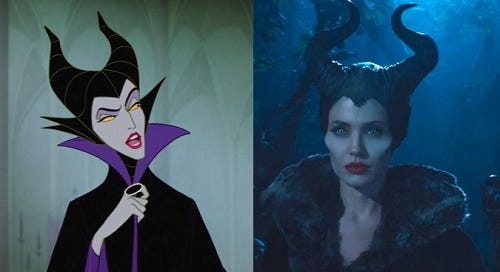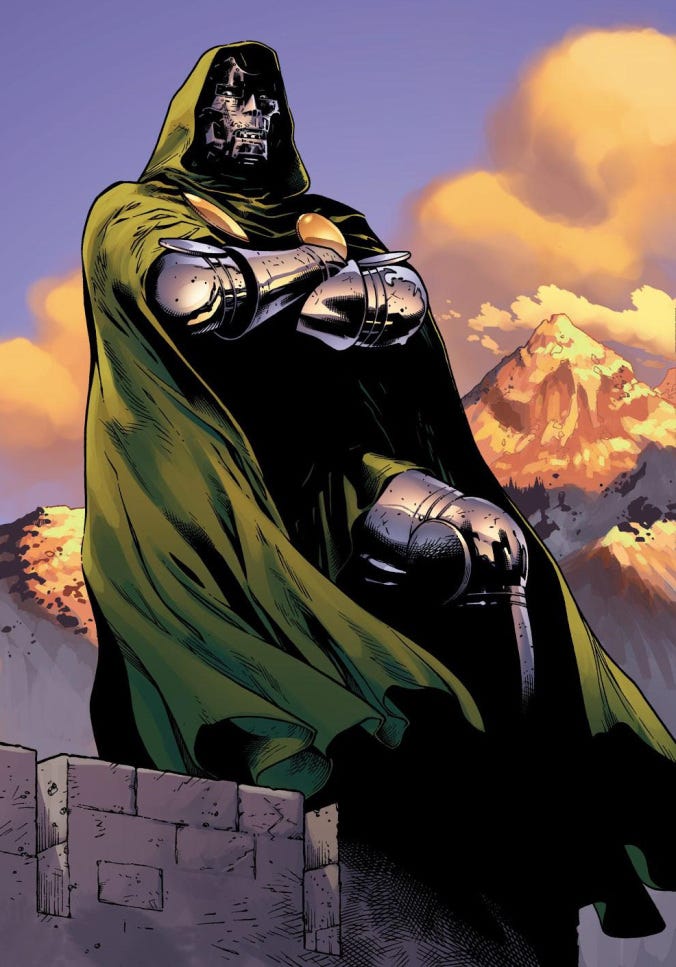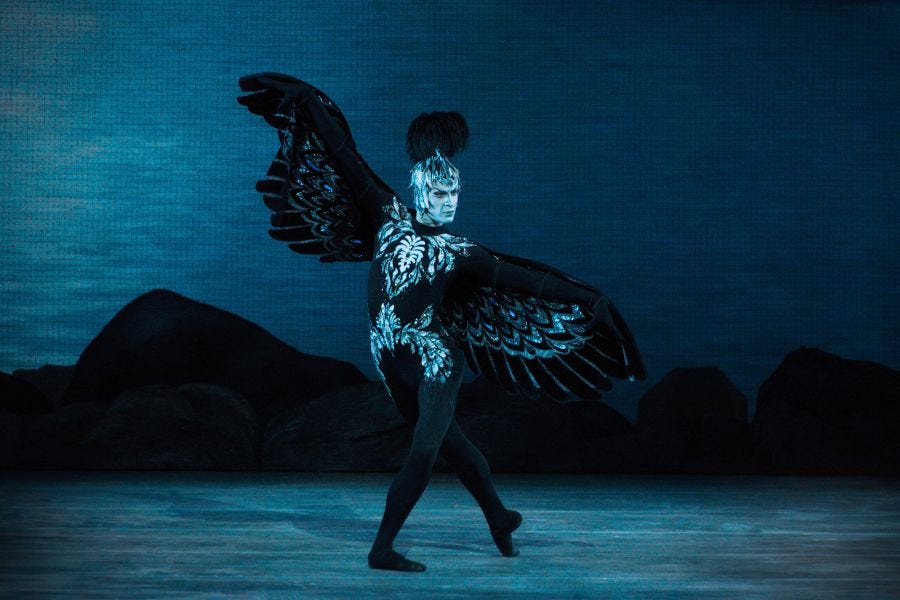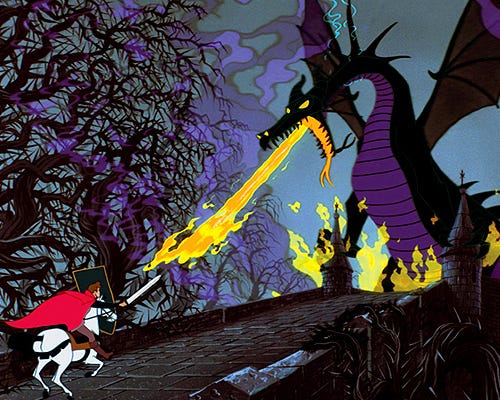Heroism is so deadly to the Degenerati [those partaking in the degenerate forces of modernity] that even villains cannot be majestic. In many of these stories, only the bad and tawdry things were exalted. True villainy, of the majestic kind, is banished.
Don’t believe me?
If you search for Malificent, both these ladies show up, but only the original version of Malificent shows up if you search for one of her most famous quotes: “Now shall you deal with ME, O Prince, and all the powers of Hell!”
There’s a reason for that.
Both these women may share the same malicious and magnificent name, but only one of them deserves it.
To those of us whose eyes are not blinded by the putrid bile that fills the eyes of the Degenerati, villainy seems, well, vile. An impressive bad guy is still a bad guy, and bad guys are bad. And so we see them, whether they are wimpy villains or majestic villains OF DOOM!
But we often prefer the majestic type, because the more impressive the villains, the more impressive the hero who defeats them.
But to those whose hearts have been corrupted, majesty itself is despised.
In real fairy tales, both the hero and the villain can be majestic. In the twisted modern stories, no one is majestic. The heroes are not brave and glorious, and the villains are not fierce and awe-inspiring.
In fact, nothing is awe-inspiring.
When Canadian psychologist and professor Jordan Peterson lectures about the nature of stories, he often returns to the story of Pinocchio. He sees Pinocchio’s transformation from doll to real boy as a symbol of the transformation we all yearn to go through, but this is not the part of the story he talks about the most. What stands out to him is the opening, in which a sweet and good man, who is kind to others, looks up at a star and yearns for a son.
More than once, he has paused to emphasize how good a person Geppetto is in the tale, how kind and generous and unselfish.
In the graphic novel series Fables, fairytale beings flooded into our world, fleeing some dire danger in their own. As they arrived, they were clearly tainted by our air, because by the time they reached the city the more noble characters had become cads and the Big Bad Wolf had become a hero.
After a time, however, the characters regrouped and decided to try to find out what was happening back home. One of the questions that reverberated throughout this period was: who was behind the terrible events in their home world?
The author of Fables had many impressive villains to choose from. Might it be the insidious Von Rothbart whose cunningly disguises his daughter Odile as the lovely Odette in order to beguile the prince and drive Odette to her death?
Or the witch from Hansel and Gretel who cackles while she eats children?
Might it be the wicked fairy from Sleeping Beauty, whom Disney made so impressive that she can call upon all the powers of Hell?
Or the ice-cold Snow Queen who can, with a shard of her mirror, turn a boy’s heart to ice?
OR the Pied Piper, who steals the town’s children when they won’t pay him for ridding them of rats?
Or the Rat King himself, the vile three-headed opponent of the Nutcracker prince?
He might have chosen any of these to be the villain worthy of his many heroes and heroine, but he didn’t. The villain behind the calamity in Fables was an evil…Geppetto?
It is not enough to have an evil snow queen or rat king, the good little man who was kind and loving must be warped beyond recognition into something vile, lest the villain be anyone who we might accidentally admire.
The same thing happened in Disney’s Maleficent.
Disney cartoons feature many fine villains, but none stand out for their force and majesty as much as Maleficent, the wicked fairy who is so angry that she has been slighted at a christening that she curses the family and tries to kill the child.
Maleficent is impressive. She is funny. And when she discovers that sixteen years later, her minions are still looking for a baby instead of a young lady, she voices that most marvelous of all villainous lines: “You are a disgrace to the forces of evil!”
But Maleficent herself is no disgrace to the forces of evil. When it comes time to fight the prince she turns into a gigantic dragon and calls upon the most infernal forces of all.
This gives her a majesty that fits with the evil magnificence of her name. She was spectacular in her villainy.
Too spectacular for the Degenerati, apparently.
In the original Sleeping Beauty – in some ways the most beautiful of all the Disney cartoons – the backdrops were done by a well-known painter. ( I used to sell his works when I worked at a gallery.) – Maleficent curses King Stephan, a man who is both a kind king and a loving husband and father. His only crime is that he left the evil fairy off his guest list. He is good, and he is innocent. The horror that befalls his nation is appalling, and he is undeserving of this terrible fate.
In the recent movie about a being who happens to have a similar look and name to our magnificent villainess, the main character, Faux-Malificent, is not majestic. She is weak and innocent. She falls in love with a man, and this dastardly individual betrays her sweet love and cuts off her wings, leaving her bereft, a victim.
How sad. How tragic. What a victim she is. No wonder she grew up to be such a...unpleasant fairy creature.
In the movie, that man is…the future King Stephan.
It is Geppetto all over again.
Big-hearted Geppetto cannot be kindly, he has to be an evil mastermind. Good-hearted King Stephan cannot be innocent, he has to be the cad who screwed over the future villainess.
Good men become cads and creeps so that the bad people, like Malificent and the Big Bad Wolf, can be misunderstood, pathetic. (Okay, I actually like Big Bad. He’s my favorite Fable character, but I like him because he’s a noir detective type like Sam Spade. He has nothing in common with the character from the fairytales who eats grandmothers and pigs.) All majesty is removed from the characters, and without majesty, there is no awe.
Because we can’t have awe.
It might accidentally remind someone of the Source of All Awe.
And that, folks – strange as this may seem – seems to be the real issue. Noble qualities, even in villains, are still noble qualities. And modern stories don’t want those. They want scum, and they want victims.
Scum and victims are not perilous.
And if there is no peril, then there can be no heroism.
Next up: Finally, after a five-year wait, the conclusion to Defending the Wood Perilous: Part Five— All About The Magic: Or the Gosling of the Golden Creek Vs. The Unicorn Pooper-Scoopers












Aaaaah, when I first found Bigby Wolf and Fables, I was thrilled. And when I found out Geppetto was behind so much wrong, I remember I was less-than-thrilled but couldn't put my finger on why. I wasn't able to articulate it.
But this article brought it all back... and now I think it must have a lot to do with the idea Arendt coined with that phrase from her work, 'the banality of evil'. I think this phrase at best captures a half truth about evil, because at the end of the day to buy into the idea that evil isn't a deeply personal thing... is to buy into one of evils most successful lies about itself. I think it is an example of 'the language of genocide' taking on an aspect that deadens the senses of those who would oppose such things. To fight the foe you have to take his measure, not believe the lies he tells himself.
Anti heroes, realpolitik, blah! Give me villains who look into the abyss with some guts, and paint the good in their chiaroscuro. Enough of this unreality posing as being more real.
.. Anyway don't mind me, just brainstorming.
PS: So when does Hans Gruber from Die Hard get his own prequel movie or show? You know he was the real victim in that movie, right? He just needed the money for his transition!